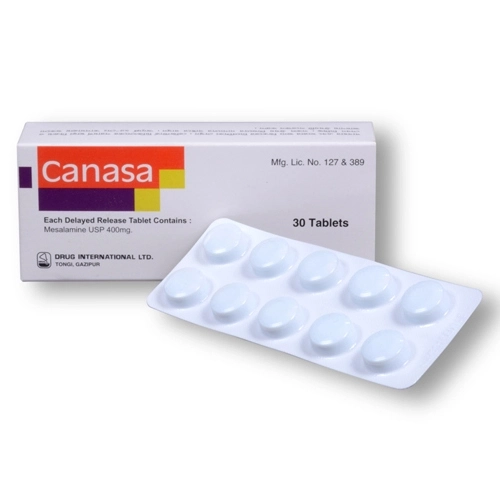Canasa Tablet (Delayed Release)
Pack ImageIndications
- Treatment of mild to moderately active Ulcerative Colitis & & Crohn’s Disease
- Maintenance of remission of Ulcerative Colitis
- Maintenance of remission of Crohn’s disease
Pharmacology
The mechanism of action of Mesalamine is unknown, but appears to be topical rather than systemic. Mucosal production of Arachidonic Acid metabolites, both through the cyclooxygenase pathways, that is, prostanoids, and through the lipoxygenase pathways, that is, leukotrienes and hydroxyeicosatetraenoic acids, is increased in patients with chronic infammatory bowel disease. Mesalamine diminishes infammation by blocking cyclooxygenase and inhibiting prostaglandin production in the colon.
Dosage & Administration
- Adult: For adults, the recommended dosage of Mesalazine is 800 mg (two 400 mg tablets) three times daily for a duration of 6 weeks. However, a dose up to 4.8 g/day in divided doses may be given if needed.
- Child: For child patients 5 years of age and older, daily dosage of Mesalazine is as follows-
| Weight Group (kg) | Morning Dosage | Evening Dosage | Duration |
| 17 to <33 | two 400 mg tablets | one 400 mg tablet | 6 weeks |
| 33 to <54 | three 400 mg tablets | two 400 mg tablets |
- Adult: The recommended dosage of Mesalazine is 1.6 g (four 400 mg tablets) daily in two to four divided doses. However, a dose up to 2.4 g/day in divided doses may be given if needed.
- Adult: 1.2-2.4 g daily in divided dose.
- Child: 400-800 mg 3 times daily.
Prolonged release granules dose: Treatment of ulcerative colitis-
Adults:
- Active disease: Individual dosage, up to 4 gm mesalazine once daily or divided into 2-4 doses.
- Maintenance treatment: Individual dosage. Recommended dosage, 2 gm mesalazine once daily.
Children 6 years of age and older:
- Active disease: To be determined individually, starting with 30-50 mg/kg/day in divided doses. Maximum dose: 75 mg/kg/day in divided doses. The total dose should not exceed 4 g/day (maximum adult dose).
- Maintenance treatment: To be determined individually, starting with 15-30 mg/kg/day in divided doses. The total dose should not exceed 2 g/day (recommended adult dose).
- It is generally recommended that half the adult dose may be given to children up to a body weight of 40 kg; and the normal adult dose to those above 40 kg.
Interaction
Contraindications
Hypersensitivity to salicylates or to any other component of the formulation.
Side Effects
The commonly reported adverse events are headache, nausea, dizziness, asthenia, dyspepsia, vomiting, pruritus etc.
Pregnancy & Lactation
It should be given in pregnancy only if the potential beneft justifes the potential risk to the fetus. Caution is advised when it is administered to a nursing mother.
Precautions & Warnings
Use in Special Populations
Elderly: Because elderly patients are more likely to have decreased renal function, care should be taken when prescribing Canasa therapy. It is recommended that all patients have an evaluation of renal function prior to initiation of Mesalamine tablets. Monitor blood cell counts during drug therapy.
Paediatric: Safety and effectiveness have not been established.
Overdose Effects
Therapeutic Class
Storage Conditions
Store below 30 0 C. Protect from light and moisture. Keep all medicines out of the reach of children.


